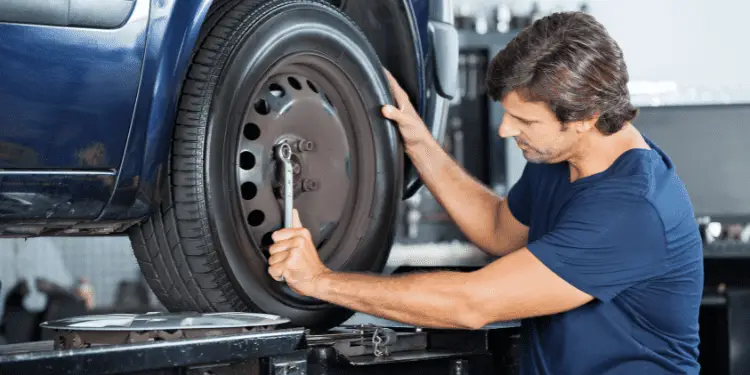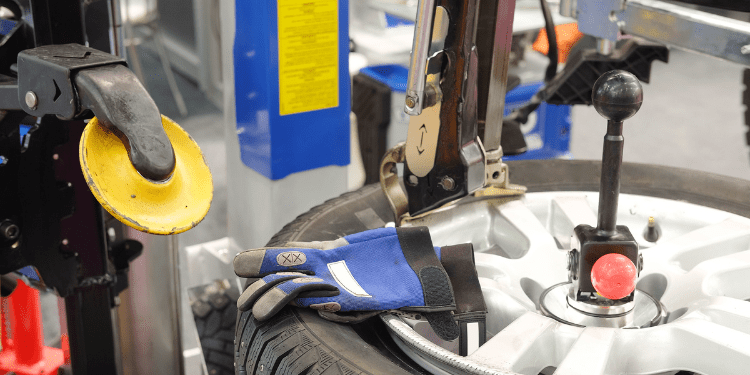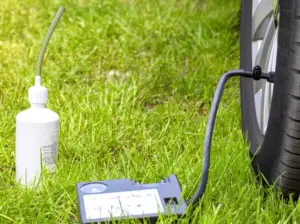We’re all busier than ever, and we have many demands on our time. We all know we need to replace our tires when worn, but how long will we be off the road?
Generally, a tire shop will take 60 minutes to fit four new tires on your vehicle or 15 minutes to fit one. A DIY mechanic with only the basic tools could take 90 minutes to fit four tires. The time taken will increase if problems with the rim, nuts, or TPMS are encountered.
It is always worth calling ahead to ensure they have your tires in stock, especially if your tires are less common.
Even if you have booked your car in some days before, on occasions, a tire shop won’t be able to get the tires you ordered but may not let you know this has happened.
When you arrive, you are then confronted with a situation where you might have to pay more to have an upgrade on tires that you didn’t expect, or you will have to leave not having your tires replaced at all. This costs you either more time or more money.
Don’t forget to take your locking lug key with you, as without it, the tire shop cannot remove your wheel to replace your tire.
If you have a new car and this is the first time your wheels are being removed or are unsure whether you do have locking wheel lugs, inspect the nuts on the wheel, and if you see one nut that has a circular circumference around the hexagonal that this is a sign that you have locking nuts.
Most car dealerships or people you’ve bought a car from will place the key in the glove compartment of your car or the trunk by the spare wheel.
So we’ve established that a professional tire shop will take about an hour to mount four new tires. Let’s go through the steps they take to get them on your car. This could be useful if you’re in the viewing area waiting.
Surprisingly there are twelve stages. We break them down below, along with how long each step takes.
How is a Tire Installed?
Jacking Up or Lifting The Car
Jacking the car up to replace four tires wastes time as it requires the jack to be moved to different points under the car. Much quicker is lifting the car up as this only has to be done once as the four legs can be positioned under the car’s jacking points and elevated.
Time Taken: Individual Jacking the car 7 minutes, Lifting the car 3 minutes.
Removing Wheels
This is a quick job for a tire shop as long as the lugs aren’t corroded or cross-threaded. All tire shops have high impact torque wrenches that take the hard physical work out of this that a lug wrench requires.

Time Taken: 3 minutes
Inspecting the Nuts, Studs, Rims, and Wheel Assembly
This is where a decent technician will spend a few minutes checking for damage that may impact safety.
It’s unusual for studs and nuts to rust, but a wheel that hasn’t been removed for a long time may have required more torque to be used to remove the wheel. This may have damaged the stud.
Brake wear to pads and rotors will be clear as they are exposed when the wheel is removed.
Although many cars have run flat tires, a decent car ship will always ask if you want your spare tire if you have one checked over. There’s nothing more frustrating than having a flat or very worn spare in the trunk when you need it.
Time Taken: 5 minutes
Remove Tires and Valve Stem from the Wheel
Before the tires are taken off the rim, they are deflated. Occasionally a bad valve stem will prevent this from happening easily, but this is easily overcome. Once deflated, the tires are placed on a rotating machine that separates the tire from the rim.
Time Taken: 4 minutes

Installing New Valve stems
A quick job for a tire shop. All valve stems are universal and will fit any wheel. A technician pulls it through the hole in the rim and tightens it up with a valve stem tool.
Time Taken: 5 minutes
Fitting New Tires
A quick check will be done to ensure the tires are the ones you ordered and that they are safe for your rim. The technician will check the DOT on the sidewall to ensure the tires have not expired.
The tire beads are coated with a fitting solution, and a rotating spreader machine is used to fit the tire to the rim.
Time Taken: 5 minutes
Inflating Tires To Manufacturer Recommended Pressure
The tire is inflated to above its standard pressure while still on the machine. This is called the ‘fitting pressure’ and ensures that the rim flange firmly secures the bead.
Once secure, the pressure is dropped back to the tire manufacturer’s recommended pressure.
Time Taken: 5 minutes

Mounting the Tires
The tires are then offered back to the wheel assembly and tightened using a wrench. Care is taken to ensure wheels and tires are fitted on the correct side of the car when directional tires are chosen.
Time Taken: 7 minutes
Balancing New Tires
Tires used to be balanced off the car, but this is now rare. An all-in-one wheel spinner and computerized balancer reader show the technician exactly where the weights need to go on the rim.
Some time will be spent getting this stage exactly right. A small imbalance can cause vibration and premature tire wear.
Time Taken: 15 minutes
Related Article: Do Rear Tires Need To Be Balanced? [COMPLETE ANSWER]
Tightening the Wheel Nuts to the Recommended Torque
The tire shop will tighten all the nuts using a torque wrench set according to the manufacturer’s guidelines. They’ll know they have reached the right torque when they hear a click.
Time Taken: 4 minutes
TPMS Reprogrammed.
Depending on your car will dictate what work a car shop will need to do to get your TPMS working well. Often a car shop will reseat the tire pressure sensor on the same ‘corner’ and rim it came from. This will help the ECU relearn quicker.
Some car’s TPMS need a 20 minute drive to instigate a relearn, which is beyond the remit of a tire shop. A good tire shop should tell you this before you drive away.
Time Taken: This varies considerably and can’t always be done without driving the car.
Many visitors read this article next: Tire Pressure Light Blinking But Everything Fine – [SOLVED]
Final Inspection & Paperwork & Payment
A short visual inspection is carried out before the car is returned to the driver. The locking nut key is often left on the front passenger seat so the driver knows it’s been returned.
A receipt and a work note will be handed over once payment has been taken and the driver is happy. Often you’ll be told to check the lugs nuts are tight after driving for 100 miles or so. This may also be stated on the paperwork you sign to say you agree at the end of the fitting.
Time Taken: 10 minutes
Other Works Often Completed At The Same Time Tires Are Fitted
Tire shop labor costs can often amount to more than the cost of a part. To save on paying double the labor costs of removing wheels, there are two other repairs or part replacements you might want to consider.
Brakes
Brake parts are generally cheap. A car shop technician will often notice if the pads or rotors are close to needing repair when replacing your tires.
If there’s not a big queue of customers after you, it’s worth asking if they’ll tell you that your brakes need attention before replacing the wheel.

Car parts can be delivered within thirty minutes, and brake pads and rotors are quick to fit too.
If they can fit them for you, you’ve saved having to book your car in again and money on labor removing the wheels for a second time.
New Tire Pressure Sensor Batteries
The wireless pressure sensor in each tire is powered by a battery with a life of approximately seven years or 100,000 miles. It’s difficult to be exact as shorter trips require more wireless transmissions, which eat into the battery life.
If your car is approaching this milestone, it’s worth asking the car shop to replace the batteries in all the sensors as they replace the valve stems.
It’s not always possible as some sensors entomb the battery in plastic, requiring a new sensor. If this is the case, it may not be cost effective, and you may be better off waiting for the TPMS light to come on and replace the sensor then.
Many visitors read this article next: Tire Pressure Light Blinking But Everything Fine – [SOLVED]
Wheel Alignment
You may be offered a wheel alignment. This is different from tire balancing, but there is often confusion.
Wheel alignments are needed if the tires you replaced show uneven wear on the inner or the outer tread section. Without an alignment, your new tires will wear in the same way.
A wheel alignment costs around $50, but if that means your tires last longer and you can avoid a trip back to the car shop anytime soon, it’s money well spent.
Other symptoms of a bad alignment are a steering wheel off-center and the car pulling to one side.
The differences: Wheel Alignment Vs. Tire Balancing
How Long Does It Take to Put A New Tire OnA Rim?
Allow up to 90 minutes to fit a new tire to a rim.
A car shop has all the tools to replace tires quickly and professionally. You might not.
If you want to safely replace a tire by yourself, there are certain tools you’ll need.
- Quality Lug Wrench
- Stable Jack
- Axle Stands
- Tire Fixing Compound
- Long Lead Air Compressor
You’ll have a lug wrench and a jack in the trunk, but these are often insufficient to do the job quickly or safely.
A bad mistake is not placing the jack correctly under the car. If you miss the jack points, you’ll cause damage lifting the car on its chassis. This could allow moisture and dirt in and rust and corrode the underside of your car. Refer to the car’s handbook to be sure.
The lug wrench is undersized if the nuts are stiff and won’t budge. A proper torque wrench has a longer handle and better leverage that’ll get the most stubborn nut loose in no time.
You’ll need tire fixing compound – the white substance – used by car shops to aid a tight fit between the rim and the tire bead.
Axle stands are a good idea for the more safety conscious. If the jack fails without them, your car will fall onto the wheel assembly damaging the CV joint and brake rotor.
A long lead air compressor is a must have. You’ll need this to inflate the tire after it’s been fitted. Tire shops use extra long leads, which allows them to stand well back when inflating new tires onto a rim.
Why? Inflating tires onto a rim is a dangerous procedure in which the tire can slip from the rim under high pressure. Tire shops always inflate tires while still on the mounting machine as an added precaution. DIY mechanics don’t have that luxury.
Can You Change a Tire Without a Jack?
It is possible, but it’s not easy. There are two ways you can try.
Method One
You’ll need to be on soft ground. Support the car’s weight by placing a tree stump or whatever else you can find under the three good tire jack points. Use a shovel to dig out around the tire you want to change over. Keep the emergency brake on. Once changed, tighten the lug nuts, fill the hole, and drive away.
Method Two
Lever up the car first using a strong metal pole – the longer, the better – and a strong pivot point like a rock. You’ll need someone to help you place supports and blocks underneath the three jack points of the wheels you’re not changing while you have the car raised slightly. Once you’ve changed the tire, remove the three supports. Knocking them on their side may be better than asking your buddy to get underneath the car.
In conclusion
Tire replacement typically takes 60 minutes for four tires. The equipment a car shop or you use dictates how long it will take. One new tire typically takes a professional technician or an experienced car owner 15 minutes to replace.


![Tire Pressure Light Blinking But Everything Fine - [SOLVED] TPMS-dash-warning](https://carzaza.com/wp-content/uploads/2023/12/TPMS-dash-warning-300x150.png)


![Why Do New Tires Keep Losing Air? [SOLVED] AIR-COMPRESSOR-FLAT-TIRE](https://carzaza.com/wp-content/uploads/2023/12/AIR-COMPRESSOR-FLAT-TIRE-300x150.png)
![Will A Cracked Rim Leak Air? [NOT ALWAYS] Tire-blowout](https://carzaza.com/wp-content/uploads/2023/12/Tire-blowout-300x224.png)






